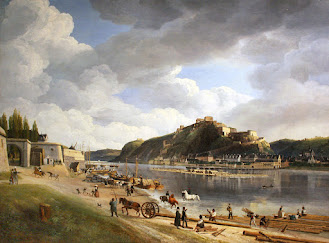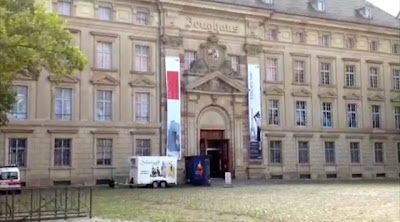The surprising Diepenbach family
In my previous blog I mentioned the brothers Theodor and August Diepenbach, who had photo studios in Roermond in the period 1867-1876. Theodor is best known in Roermond as the photographer of the historic procession in June 1868, which depicted the entry in 1602 of Albertus, Archduke of Austria. The people of Roermond have turned it into a beautiful spectacle with lots of music and a parade of people dressed in historical costumes. Theodor Diepenbach made an overview photo of the historical groups that gathered on the market square, plus a number of cartes-de-visite of individual characters.
 |
| Historic groups 1868. Source: Archive Roermond. |
My research over the past weeks has focused on Theodor in particular and has yielded some fascinating data. Theodor was born in Coesfeld on December 9, 1829. He married Emilie Klefisch, who was born in Cologne on June 3, 1838. As children I found: Augusta (1865 or 1866), Elise (1867), Theodor junior (1868) and Marie (1870).
A striking feature of Theodor's career is the large number of changes of cities and addresses where he has lived or worked: in any case Coesfeld, Kleef, Cologne, Roermond, Venlo, Tilburg, Eindhoven and Düsseldorf. He often moved from one address to another within a city. Cleves seems to have been a base of operations for many years: his children were born there and in other cities he often called himself “photographer from Cleves”. In 1874, however, he sold his studio there.
 |
| Roermond ad, October 12, 1867 |
In the summer of 1882 the family arrived in Antwerp with the intention of settling there. However, the authorities were not fond of this. It turns out: Theodor was convicted three times in Germany for pimping and in Antwerp the family is also involved in prostitution. Some girls living with them, Berthe Müller (22 years old) and Catherine Schutz (20 years old), and eldest daughter Augusta stroll along the street past the cafes and talk to men. When they are arrested for illegal prostitution, Berthe makes a confession, but she declares that 17-year-old Augusta would only accompany her on her streetwalks. The conclusion of the police commissioner is clear: the Diepenbach family leads an ambiguous existence; her resources come largely from prostitution. But evidence is hard to get.
A remarkable detail is that father Theodor is usually in Eindhoven for his work as a photographer. Mother Emilie would then be the madam of the bunch. Anyway, in October 1882 they are expelled from the country.
 |
| Part of a police report telling that the resources largely come from prostitution, September 1882, Antwerp. Dossier 481#49269. |
Apparently Augusta and Elise see a future in the business, because in 1900 they are active again in Antwerp as operators of the bar “Aux caves Portugaises”. They employ some girls as waitresses and the police are convinced they are engaged in prostitution. According to statements, with the purchase of a bottle of champagne one could have a girl. However, hard evidence was difficult to provide. Yet the ladies are again expelled from the country.
Düsseldorf will be Theodor's last city, but he no longer practices there. From 1889 to 1901 the Diepenbachs are fully present: father Theodor, mother Emilie, son Theodoor and the sisters Diepenbach. All the Diepenbachs live at constantly changing addresses and it is unclear whether Theodor senior always lives at the same address as his wife. They do not seem to be poor, because in 1891 and 1892 the sisters owned Kaulbachstrasse 7. In 1893 senior is owner of Kaulbachstrasse 9. From at least 1895 to 1900 Emilie owned Louisenstrasse 64. This is also the address where Theodor senior lived when he died on September 15, 1894. In any case, the widow did not live at 94 Louisenstrasse from 1895. She rents out the rooms of the building to workers and craftsmen with a small income. Where she lived is unknown. Only in the 1901 address book do we see a glimpse of her when she rents an appartment herself between factory workers and locksmiths at 23 Kaulbachstrasse.
Augusta and Elise are registered as fashionists in Düsseldorf. Elise owns the property at 31 Lessingstrasse, where she lives with Augusta until she dies in 1911, only 44 years old.
 |
| CdV by Theodor junior, 1895-1896. Source: Delcampe |
Finally son Theodor. In the 1890s he was based in Düsseldorf as a photographer under the name G.O. Diepenbach. Like his father, he is at a different address every few years. In 1899 he moved to Berlin, where for many years he had a well-run studio with a branch and a publishing house. He died on August 8, 1924.
 |
| Death certificate of Theodor senior, Düsseldorf #2489, 1894 |














































